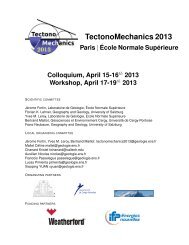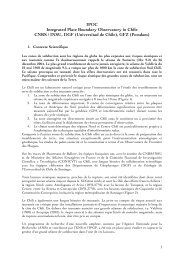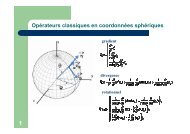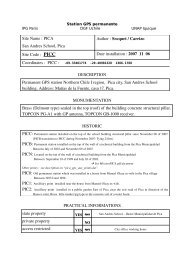PDF file - Laboratoire de Géologie de l'Ecole normale supérieure - Ens
PDF file - Laboratoire de Géologie de l'Ecole normale supérieure - Ens
PDF file - Laboratoire de Géologie de l'Ecole normale supérieure - Ens
You also want an ePaper? Increase the reach of your titles
YUMPU automatically turns print PDFs into web optimized ePapers that Google loves.
6<br />
SOCQUET ET AL.: GPS MEASUREMENTS TO REFINE INDIA/SUNDA RELATIVE MOTION<br />
Figure 4: Main Myanmar structures, shallow CMT<br />
focal mechanisms, GPS velocities with respect to the<br />
Sunda Plate (black arrows). The motion to be<br />
accommodated between the GPS points is also reported.<br />
and Pubellier, 2005; Wang and Burchfiel, 1997; Wang,<br />
et al., 1998]. East of YWEN, the shallow seismicity of<br />
strike-slip type attests that this intracontinental strain<br />
probably extends to the Shan Plateau (Fig. 4). West of<br />
the plateau, the relative motion between KWEH and<br />
YWEN indicates that the Sagaing fault accommodates<br />
about 18 mm/yr of right-lateral strike-slip. This slip<br />
amount agrees with the previous geo<strong>de</strong>tic solution<br />
[Vigny et al., 2003] and the neotectonic studies<br />
[Bertrand, et al., 1998]. In the Arakan Range (western<br />
Myanmar), MIND station moves 24 mm/yr north with<br />
Figure 5: Velocity diagrams showing the distribution<br />
of <strong>de</strong>formation across central (top) and southern<br />
(bottom) Myanmar. The plain grey arrows represents<br />
India / Sunda motion, small circles represent the plates<br />
location in the velocity space, black arrows represent<br />
the measured GPS velocities with respect to the Sunda<br />
Plate, and the numbers show the amount of motion to<br />
be accommodated between the points of the velocity<br />
diagram (GPS stations or tectonic plate).<br />
respect to Sunda (Fig. 4). With respect to India, this<br />
station moves 14 mm/yr toward the south-west (Fig.<br />
2). We summarize in Fig. 5 the various GPS<br />
constraints in the form of synthetic velocity diagrams.<br />
In the velocity vector diagram constructed at this<br />
latitu<strong>de</strong> (Fig. 5, top), the three heads of the vectors<br />
<strong>de</strong>scribing the motion of the Indian Plate, KWEH and<br />
MIND sites with respect to the Sunda Plate are aligned.<br />
This implies that the motion to be accommodated<br />
between the Indian Plate and the Myanmar central<br />
basins (KWEH point) has a constant azimuth. LAUN






